The oil slick that began forming when the Deepwater Horizon platform exploded on April 20 is causing concerns for NASA as well. Officials at the American space agency announce that the extending slick is causing troubles for a ship that is supposed to deliver a massive space shuttle fuel tank. The component is absolutely essential for the penultimate planned shuttle launch, that of Discovery in September. NASA barges generally travel between Louisiana and Florida via a set of deep-water routes, which have now been compromised by the disaster, Space reports.
The huge fuel tanks are manufactured at the Michoud Assembly Facility, in New Orleans, and are then loaded onto barges. Tugs then pull the ship, and the 15-storey tank, through specific routes, all the way to the Kennedy Space Center, in Cape Canaveral, Florida. In an announcement made yesterday, space shuttle program manager John Shannon said that the vessel which was supposed to make the new transport was not equipped to navigate the shallow water existing around the oil slick. The NASA recovery ship Freedom Star is used either for tank delivery or for recovering the twin solid fuel boosters that space shuttles eject over the Atlantic Ocean during launch.
“It's kind of stuck in Gulfport, Mississippi right now because of the oil slick. They've had to take a different path with the barge and the Freedom Star cannot do that shallow-water course to Michoud,” the official said in a press conference. The Discovery fuel tank is currently placed aboard a barge called Pegasus, that is still in Michoud, and which needs to rendezvous with Liberty Star. Though operations to connect the two vessels have already begun, they still have a 900-mile (1,450-kilometer) journey ahead, until they reach the KSC. NASA officials estimate the distance will be covered in six days.
On April 20, the Deepwater Horizon oil rig exploded in the Gulf of Mexico. Two days later, on April 22, it sank into the waves, and came to rest on the bottom of the ocean. Since then, thousands of barrels of crude oil have been spilling into the Gulf each day, and the ensuing oil slick now threatens Louisiana coastlines, delicate natural reserves, as well as beaches belonging to several cities. Over this weekend, changing winds hampered clean-up efforts, just like they did last weekend. Numerous vessels belonging to BP, the oil company that operated the semi-submersible platform, and state and federal authorities are attempting to deploy various blocks that could stop the oil slick from advancing towards the coast.

 14 DAY TRIAL //
14 DAY TRIAL //